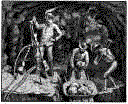
The Coal Mine Camps of Sheridan County, WY

|
|
The Coal Mine Camps of Sheridan County, WY |
|
The following article is reprinted from the book Sheridan County Heritage, published in 1983. We dedicate this page to the memory of Stanley Kuzara, 1906-2000.
THE
COAL MINE CAMPS and MINES
OF THE SHERIDAN, WYOMING AREA
by Stanley A. Kuzara
Homesteaders soon discovered that, even with the abundance of wood, this coal made a superior fuel because of its low-burning capacity, at the same time producing a more evenly distributed heat, thereby making it desirable for both domestic and industrial use.
Many whose lands contained such outcroppings began offering it for sale through advertisements in the local papers where people could either dig their own coal or have it delivered to them.
It was not until the year 1893 on March 3rd, that the production of coal as an industry became a reality. Mr. C. H. Grinnell (later Mayor of Sheridan), J. R. Phelan, George T. Beck and Anson Higby formed a corporation, the Sheridan Fuel Company, on lands approximately four miles north of Sheridan, Wyoming.
Word spread quickly. People from the east, mostly of foreign extraction, began to pour into this region. A company-owned mining camp was formed. it was not long before a thriving camp came into being. The camp was named Higby, after one of the incorporators.
This industry attracted the attention of some midwestern capitalists, principally Mr. C. M. Dietz of Omaha and his brother, Gould Dietz, both of whom became involved. Gould Dietz became treasurer of the company, and the name of the camp was changed to Dietz just before the turn of the century.
In the meantime, under the very able supervision of Stewart Kennedy, who became the superintendent of the mining operation, the operation was expanded with ever increasing orders for the product. The Burlington Railroad restructured the grates in their engines, which previously could use only eastern hard coal and were then able to use local coal to fuel their engines.
Studies revealed that there existed more than one layer (vein) of coal at varying depths. In 1901, a second mine, Dietz #2, was dug. This mine was a shaft mine going straight down into the earth, as opposed to those mines such as Dietz #1, which sloped into the hillside.
There were a few tents and shacks where some of the miners lived near the Dietz #2 mine, but most of the employees lived in the main Dietz camp. By 1901, it was considered "A Busy Little City," as described in an issue of The Sheridan Post.
By 1904, a third mine was sunk just south of the main camp, but for some reason, was very short-lived. Then came Dietz #4 which, using the same slope as Dietz #1, extended to a second vein. Dietz #5, a slope mine located about a mile north of Dietz, followed. This had a camp of its own. Dietz #6, just about two miles north of Sheridan, had no camp and operated only a short while.
Soon followed Dietz #7, which, again, used the same slope as #1 and #4 and was extended further to still a deeper vein. By this time, Dietz camp was really quite a busy little city with two churches, two schools - the lower grades and the "high school" (so called because it had two stories), the company store, two saloons, pool hall, union hall, hotel, etc.
The last of the Dietz Camps was Dietz #8, located in the same location as Dietz #5. This mine was a shaft mine extending some 180 feet down to a vein of coal of superior quality, but still a sub-bituminous coal.
In the meantime, other mines had sprung up north of the Dietz #8 mine. The Hotchkiss mine (sometimes called the Shoestring mine) was located only about a mile away. Although there were a few houses located there, no camp ever existed. Most of the employees lived in Dietz #8. This mine shipped its coal by rail to other markets, as did the Dietz mines, and existed from 1918 until 1940. R. A. Keenan was its president, and R. F. Hotchkiss, vice-president, with R. E. McNally, an attorney in Sheridan, secretary-treasurer.
Proceeding north about two miles or about five miles north of Sheridan, was the Acme mine and camp. In 1911, Archie K. Craig, who previously had opened a mine in about 1907, about 10 miles north of Sheridan, called the old Acme Mine, started this camp.
Acme was a very modern camp, well-designed and well-stocked with shrubbery and trees. This camp had its company store, Post Office, mine office, union hall, theater, school, hotel, etc.
The mine itself was a slope mine across the Tongue River. Big Goose Creek and the Tongue River joined just below the camp. This mine operated until 1940. The camp remained occupied until about 1950. In 1953, the town was purchased by one of the employees of the company. In 1963, it received nationwide publicity when it was advertised for sale in an eastern paper. Eventually, this camp was acquired by the Big Horn Coal Company, which has since strip-mined the area.
Approximately a mile north of Acme there was the Model Mine and small camp. This was another shaft mine begun in 1911 and closed in about 1921. Stewart Kennedy, the former superintendent of the Dietz mine, was the superintendent of this mine and one of the owners. Others involved were John Peters, D. A. Fessler, J. W. Rivey and Frank W. Smith.
Carneyville, the fifth camp in the area, was located just west of Model about seven miles north and west of Sheridan.
In 1904, it was a camp teeming with activity. The various businesses included the company store. This mine was actually two mines with two entries across Tongue River and two tipples on the opposite side, the camp side. A Catholic Church located on a hillside overlooking the camp had a burial-ground nearby, which today sits along Highway 90 [Interstate 90].
In 1920's, the properties were acquired by the Peabody Coal Company. Most of the coal in the valley was owned by it. A contest was conducted for a suitable name for the product. When one of the stenographers in the Chicago office came up with the name Kleenburn, the camp of Carneyville was renamed Kleenburn. The coal of the valley was called "Kleenburn Coal."
Still another and larger mining camp was located about a mile west of Kleenburn. This camp was called Monarch. Begun in 1903 by Stotts and Edleman, it remained in existence until 1953. Stewart Kennedy was involved in the operation of the mine in its earlier stages.
By 1907, a new corporation was formed for the Monarch mine, with J. A. Kendrick, President; L. H. Brooks, Vice-President; William C. Ervine, SecretaryTreasurer; and Stewart Kennedy, Superintendent. During the existence of this camp, there existed several openings in the immediate vicinity.
The coal mine and camp of Kooi was owned and operated by Mr. Peter Kooi (pronounced Coy). He had been associated with the Monarch mine. He organized a very modern camp with company-owned houses and the usual store, post office, etc. This mine was located about two miles west of Monarch.
Mr. Kooi was very proud of his employees and, in return, he, his wife and daughters were greatly respected by them. He was a great promoter of programs to benefit the miners, such as an organized band, a fine baseball team, Christmas parties, etc.
In addition to the so-called "Railroad Mines" - those equipped to ship coal by rail - there existed a number of "Wagon Mines," those restricted to merely local consumers who would haul their own coal.
There were the Storm King Coal Company and the Black Diamond Mines located a few miles west of Sheridan on the Big Goose Road; the Riverside Mine about 10 miles northwest of Sheridan; the Schreibeis mine located near Decker, Montana; the old Acme mine near the old Riverside mine; Custer Coal Company, about four miles north of Sheridan between Dietz #7 and Dietz #8; the Hart mine near Dietz #7 and the Star Mine, owned by George Kuzara, located about two miles north of Sheridan.
Then there was the Welch Mine, located between Kooi and Ranchester, owned and operated by William Welch. After the Acme mine ceased operating and quit supplying the power plant of the Montana-Dakota Utilities, Mr. Welch became the main supplier. He was one of the first operators to strip mine his coal, and continued until MDU closed down their generating plant.
In the late 1940's, the underground coal mines ceased to exist. The Big Horn Coal Company, with its huge draglines, enormous trucks, and related heavy equipment, completely changed the approach to coal mining with a process called "strip mining." Thus began a new era with various companies competing for control of this valuable source of energy.
A more detailed history on this subject may be found in a book entitled, "Black Diamonds of Sheridan - A Facet of Wyoming History," published in 1978. [See the Index to this book]

Back to Mining in Wyoming Home Page